COMMENT OF THE DAY: A QUICK ALLEN PARKVIEW VILLAGE RECAP FOR HOUSTON NEWCOMERS 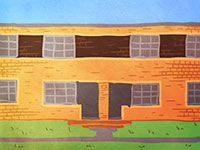 “. . . Back in the 1920s, the 4th Ward was Houston’s version of Harlem during the Harlem Renaissance. Racist white city officials did not want a thriving African American community right next to a rapidly growing downtown and demolished a huge section of the community to build public housing (the decisive blow to the 4th ward would be extending the freeway through the community, effectively cutting it off from downtown). APV was designed by MacKie & Kamrath and was intended to be public housing. It ended up as all white housing for veterans. Eventually, African Americans moved in as whites moved out and headed to the suburbs. In the ’70s, as the City was booming again, City officials wanted to demolish APV as it, and much of the rest of the 4th ward, was falling into disrepair. Every single move after that was just controversy on top of controversy. The City was accused of moving Vietnamese immigrants into APV to dilute the number of African Americans who opposed demolition. Then, there was a big master plan project proposed to redevelop the entire area, a court case over demolition of APV and designation of APV and the Fourth Ward on the national register of historic places. In the end, more than half was demoed and replaced with new apartments in 2000. The original MacKie & Kamrath designed buildings are architecturally and historically significant. But, like the history of the 4th ward, Houston’s transient population knows very little about the trials and tribulations behind APV. So, it is an easy target to troll for hate on preservationists.” [Old School, commenting on Comment of the Day: An Alternative Plan for the Site Next to Allen Parkway Village] Illustration: Lulu
“. . . Back in the 1920s, the 4th Ward was Houston’s version of Harlem during the Harlem Renaissance. Racist white city officials did not want a thriving African American community right next to a rapidly growing downtown and demolished a huge section of the community to build public housing (the decisive blow to the 4th ward would be extending the freeway through the community, effectively cutting it off from downtown). APV was designed by MacKie & Kamrath and was intended to be public housing. It ended up as all white housing for veterans. Eventually, African Americans moved in as whites moved out and headed to the suburbs. In the ’70s, as the City was booming again, City officials wanted to demolish APV as it, and much of the rest of the 4th ward, was falling into disrepair. Every single move after that was just controversy on top of controversy. The City was accused of moving Vietnamese immigrants into APV to dilute the number of African Americans who opposed demolition. Then, there was a big master plan project proposed to redevelop the entire area, a court case over demolition of APV and designation of APV and the Fourth Ward on the national register of historic places. In the end, more than half was demoed and replaced with new apartments in 2000. The original MacKie & Kamrath designed buildings are architecturally and historically significant. But, like the history of the 4th ward, Houston’s transient population knows very little about the trials and tribulations behind APV. So, it is an easy target to troll for hate on preservationists.” [Old School, commenting on Comment of the Day: An Alternative Plan for the Site Next to Allen Parkway Village] Illustration: Lulu
Tag: Public Housing
COMMENT OF THE DAY: AN ALTERNATIVE PLAN FOR THE SITE NEXT TO ALLEN PARKWAY VILLAGE  “. . . In an ideal world, I think that the City should’ve recognized that there was an opportunity for the HHA to acquire this site and work with a private-sector master developer to completely demolish the existing complex and integrate government housing into a much more intensively developed project on this extremely high-profile site. Doing so would’ve bypassed some of the issues that they’ve since encountered with the adverse SCOTUS ruling. It wouldn’t have been cheap, but it would’ve also tastefully incorporated government housing into a project that could have mitigated the externality of APV on the areas around it and established an open street grid. Doing so would’ve made everything around there and along the Buffalo Bayou much more desirable and accessible, and leveraged the tax base upward over a large area. However, that also wouldn’t have been uncontroversial; some people think that the original Allen Parkway Buildings are architecturally significant enough to warrant their preservation. In any case, that ship probably has sailed. . . .” [TheNiche, commenting on Your Best Look Yet at the Shiny Highrises Fitting Between Allen Parkway Village and the Federal Reserve] Image: Tianqing Real Estate Development/DC Partners
“. . . In an ideal world, I think that the City should’ve recognized that there was an opportunity for the HHA to acquire this site and work with a private-sector master developer to completely demolish the existing complex and integrate government housing into a much more intensively developed project on this extremely high-profile site. Doing so would’ve bypassed some of the issues that they’ve since encountered with the adverse SCOTUS ruling. It wouldn’t have been cheap, but it would’ve also tastefully incorporated government housing into a project that could have mitigated the externality of APV on the areas around it and established an open street grid. Doing so would’ve made everything around there and along the Buffalo Bayou much more desirable and accessible, and leveraged the tax base upward over a large area. However, that also wouldn’t have been uncontroversial; some people think that the original Allen Parkway Buildings are architecturally significant enough to warrant their preservation. In any case, that ship probably has sailed. . . .” [TheNiche, commenting on Your Best Look Yet at the Shiny Highrises Fitting Between Allen Parkway Village and the Federal Reserve] Image: Tianqing Real Estate Development/DC Partners
HOUSING AUTHORITY: OUR FLOODED CLAYTON HOMES DEVELOPMENT WAS GOING TO BE DEMOLISHED ANYWAY 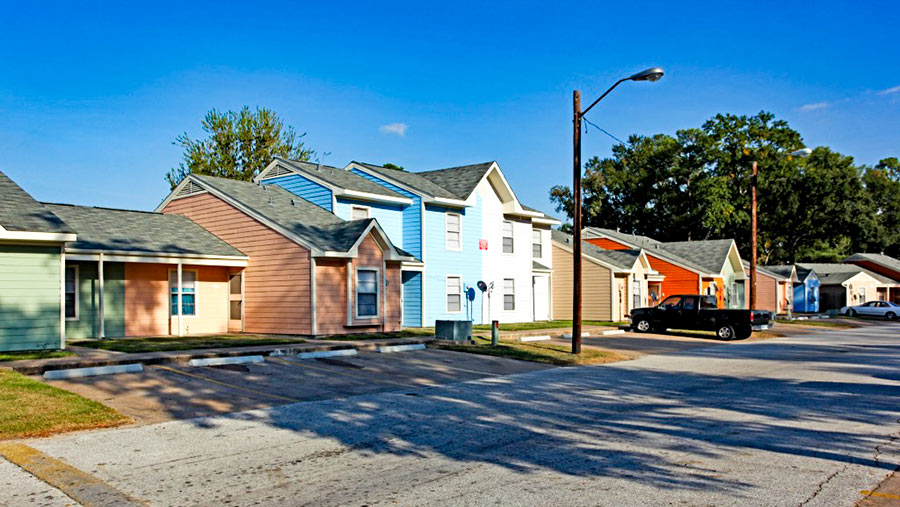 A new statement from the Houston Housing Authority provides a little more background on its decision to demolish 112 of the 296 units at the authority’s Clayton Homes low-income housing neighborhood just east of Hwy 59 at the northern tip of EaDo. The homes were deemed “uninhabitable” after flooding from Hurricane Harvey triggered mold and other health concerns: “HHA decided demolition was the best course of action for the damaged units since the entire property is located on land acquired by eminent domain and will face eventual demolition for TxDOT’s I-45 freeway extension. When the remainder of Clayton units are demolished in a few years, the remaining residents will either be relocated to another public housing unit or receive HCVs.” Housing Choice (formerly Section 8) Vouchers — along with moving assistance and payments — are also being provided to residents of 82 out of the 100 units at another Housing Authority development, Forest Green Townhomes at 8945 Forest Hollow St. in northeast Houston, which the authority today announced had also been rendered unlivable by the storm. [Houston Housing Authority; previously on Swamplot] Photo of pre-Harvey Forest Green Townhomes: Forest Green
A new statement from the Houston Housing Authority provides a little more background on its decision to demolish 112 of the 296 units at the authority’s Clayton Homes low-income housing neighborhood just east of Hwy 59 at the northern tip of EaDo. The homes were deemed “uninhabitable” after flooding from Hurricane Harvey triggered mold and other health concerns: “HHA decided demolition was the best course of action for the damaged units since the entire property is located on land acquired by eminent domain and will face eventual demolition for TxDOT’s I-45 freeway extension. When the remainder of Clayton units are demolished in a few years, the remaining residents will either be relocated to another public housing unit or receive HCVs.” Housing Choice (formerly Section 8) Vouchers — along with moving assistance and payments — are also being provided to residents of 82 out of the 100 units at another Housing Authority development, Forest Green Townhomes at 8945 Forest Hollow St. in northeast Houston, which the authority today announced had also been rendered unlivable by the storm. [Houston Housing Authority; previously on Swamplot] Photo of pre-Harvey Forest Green Townhomes: Forest Green
HOUSING AUTHORITY READY TO DEMOLISH MORE THAN A THIRD OF CLAYTON HOMES AFTER HARVEY FLOODING 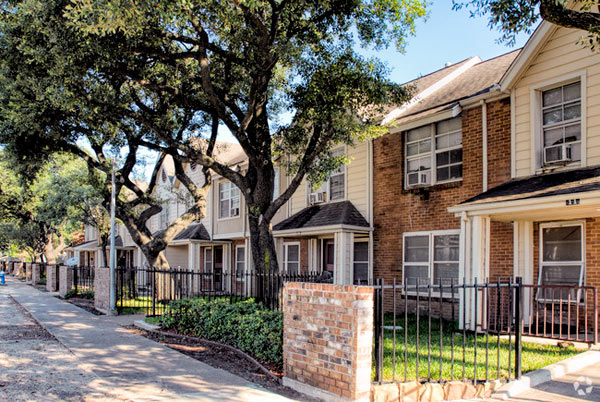 112 of the 296 apartments at Clayton Homes have been deemed “uninhabitable” by its owner, the Houston Housing Authority, which is now seeking to demolish them. The affordable-housing complex tucked between Hwy. 59 and Buffalo Bayou north of Runnels St. in the northwest corner of the East End was flooded after Hurricane Harvey; subsequent investigations conducted by local researchers led by the New York Times and by the authority found numerous health and safety problems in the residences, including festering mold and high levels of E. coli. Submitting a demolition request for those units allowed the authority to receive and distribute “tenant protection vouchers” that will allow their residents to relocate to any voucher-accepting unit in the city, a spokesperson for the agency says: “Since Hurricane Harvey caused extensive damage to many of HHA’s public housing properties, housing options within HHA’s public housing program are now exhausted, which is why residents are receiving vouchers.” The agency says it is also helping Clayton Homes residents not eligible for the vouchers as well to find new homes — with relocation assistance services and one-time payments — and that it is refunding rents collected for periods when homes in the complex were uninhabitable. Photo: Apartments.com
112 of the 296 apartments at Clayton Homes have been deemed “uninhabitable” by its owner, the Houston Housing Authority, which is now seeking to demolish them. The affordable-housing complex tucked between Hwy. 59 and Buffalo Bayou north of Runnels St. in the northwest corner of the East End was flooded after Hurricane Harvey; subsequent investigations conducted by local researchers led by the New York Times and by the authority found numerous health and safety problems in the residences, including festering mold and high levels of E. coli. Submitting a demolition request for those units allowed the authority to receive and distribute “tenant protection vouchers” that will allow their residents to relocate to any voucher-accepting unit in the city, a spokesperson for the agency says: “Since Hurricane Harvey caused extensive damage to many of HHA’s public housing properties, housing options within HHA’s public housing program are now exhausted, which is why residents are receiving vouchers.” The agency says it is also helping Clayton Homes residents not eligible for the vouchers as well to find new homes — with relocation assistance services and one-time payments — and that it is refunding rents collected for periods when homes in the complex were uninhabitable. Photo: Apartments.com
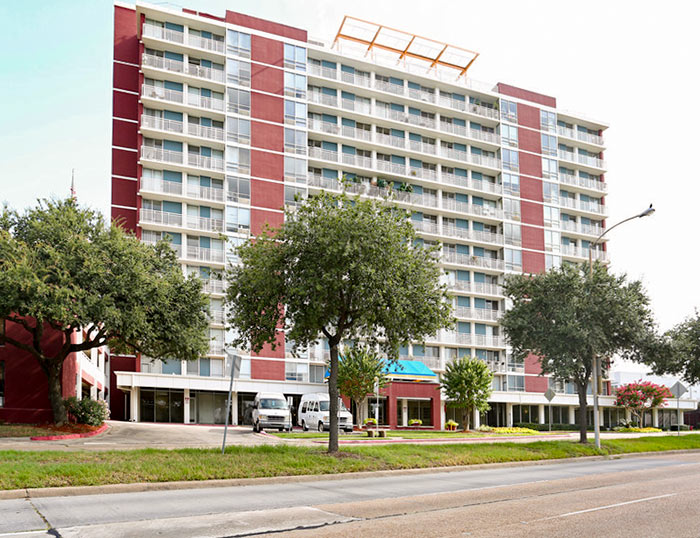
A notice sent yesterday to all tenants of the 2100 Memorial senior-living facility just west of Downtown declares that the 14-story former Holiday Inn has been rendered “totally unusable for residential purposes” in the aftermath of Hurricane Harvey. All 198 elderly residents have been given 5 days to remove themselves and their belongings from their apartments.
The building is a tax-credit property of the Houston Housing Authority that includes both low-income and market-rate units. The notice, which came from V.J. Memorial Corp., a nonprofit entity owned by the authority, states that the company only recently learned that the building’s electrical and fire control systems were compromised by the flooding.
“Due to the damage and health & safety reasons, the building is uninhabitable and we must exercise our right under your lease to terminate the lease effective September 23, 2017,” reads the notice, a copy of which was obtained by Swamplot. A separate lease termination document sent in by a reader declares that “the damage to the Apartment is so extensive the Apartment has become as a practical matter totally unusable for residential purposes due to health and safety reasons. Furthermore, the damage could cause health and safety hazards to you and your family, if you returned to live in the Apartment in its present condition.” Residents have until 5 pm on the 23rd to get out: “If you do not remove your personal possessions by that time. we will be forced to remove your possessions and store them at a cost to you,” the document states.
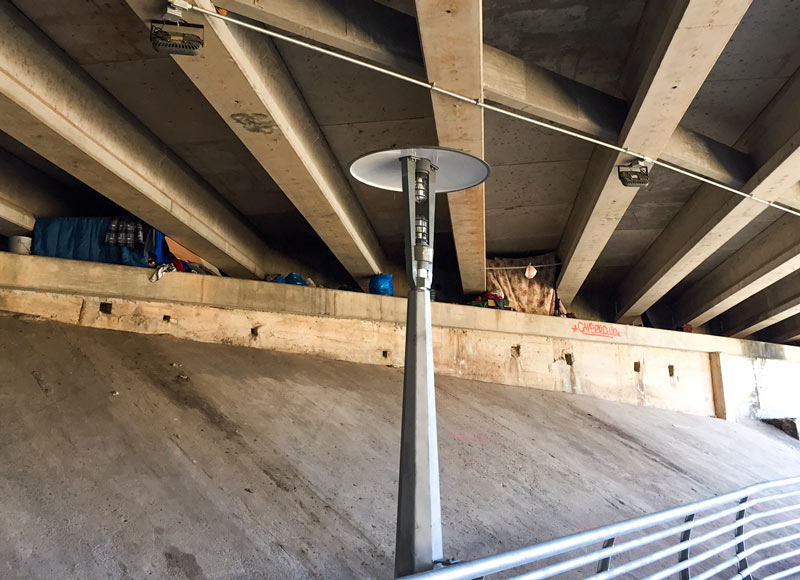
Among the flurry of in-the-works policies Mayor Turner announced yesterday related to reducing the number of homeless folks in Houston: some staffed bare-bones shelters consisting of at least a fence, a roof and a bathroom, either under overpasses or on private land. Just where would those be set up? The city says they’ll be looking for suggestions from city council members and communities of spots in their own districts where shelters and services might be a good fit.  Per Rebecca Elliott’s report, Turner told the Chronicle this week that he thinks it’s “important for people who are saying ‘we don’t want them here’ to join in with us in helping to identify acceptable locations.”
Here’s a list of other plans floated yesterday, none of which yet come with an expected price tag:
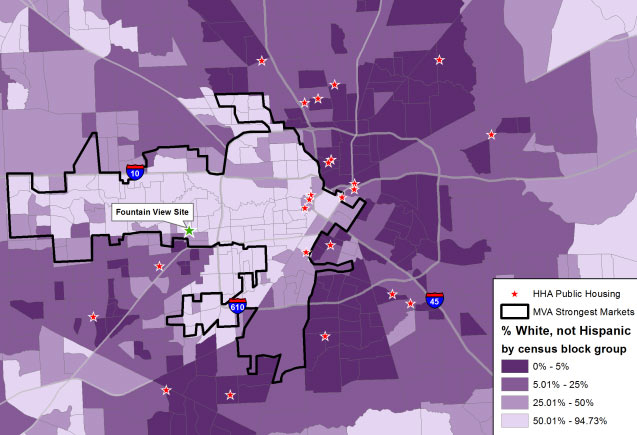
The pale arrow pointing from W. Beltway 8 to Downtown in the map of Houston above is made up of census blocks recorded as more than 50 percent white, according to a post by Will Livesley-O’Neill for Texas Housers yesterday. The Austin-based nonprofit, which researches low-income housing policy around the state, published yesterday’s article as a followup to some previous posts about the mixed-income housing complex that HHA is planning for the site of its own office building on Fountain View Dr. in Briargrove. The demographic breakdown on the other 3 shades shown on the map, from lightest to darkest: 50 to 25.01 percent white, 25 to 5.01 percent, and 5 to 0 percent.
The map also marks the locations of existing Houston Housing Authority public housing developments as red stars, mostly outside of or skirting the majority-white census blocks; the proposed Fountain View housing site is singled out, tagged, and marked with a green star. Meanwhile, the black outline looping mostly around the majority-white areas is lassoing the market areas deemed strongest by the Reinvestment Fund‘s Market Value Analysis for the city.
- Video: Anger over proposed public housing in high opportunity Houston neighborhood [Texas Housers]
- Previously on Swamplot: The Mixed-Income Housing Project That Would Replace Houston Housing Authority’s Own Office Building in Briargrove
Map: Texas Housers

Signs are now up along the feeder road of the East Fwy. near Gregg St., a reader tells Swamplot, announcing an impending construction project on the site where last year demolition crews removed 63 units belonging to the Kelly Village Apartments that had been left to decay after sustaining damage from Hurricane Ike. Scheduled to go up soon in its place is the $800,000 freeway-side park illustrated above, which was announced last year. The 3-acre site near the confluence of I-10 and Hwy. 59 will include a playground, jogging and walking trails, exercise spots, and a community garden.
- Previously on Swamplot:Â Mom’s Letter Leads City To Raze Derelict Fifth Ward Housing
Rendering: Houston Housing Authority
COMMENT OF THE DAY: A BRIEF ANNOTATED HISTORY OF ALLEN PARKWAY VILLAGE’S DIRTY NEIGHBOR  “Wow, I never knew there was a waste incinerator right in the Fourth Ward. Here’s a handy timeline:
Post-Civil War: Freed slaves construct their own neighborhood in the Fourth Ward.
1917: Camp Logan Race Riots are sparked off when a Houston policeman beats a black soldier in the Fourth Ward.
1920s: Gillette incinerator is built (PDF) right in the Fourth Ward.
1944: San Felipe Courts (today’s Allen Parkway Village) were built next to the incinerator. They were originally intended as public housing for the city (following a New Deal movement for public housing in the 1930s) but ended up being handed over to the defense department to exclusively house white WW2 veterans (PDF). The other motivation was to ‘clean up the slums’ along Allen Parkway for passing commuters.
1964: San Felipe Courts are desegregated following the Civil Rights Act and renamed to Allen Parkway Village.
1970s-90s: Developers advocated for APV’s demolition arguing that the public housing’s costs didn’t reflect the land’s ‘highest and best use.’ Meanwhile, the housing deteriorated due to neglect by the Houston Housing Authority and HUD. Residents organized and protested demolition leading to APV’s rebuilding in 1997.
Today: The city can now cash in by selling a plot of polluted land next to APV now that the Fourth Ward is gentrifying.” [Carpetbagger, commenting on The Best the City Can Get for Gillette; Not Jus Donuts’ Extreme Cakeover] Illustration: Lulu
“Wow, I never knew there was a waste incinerator right in the Fourth Ward. Here’s a handy timeline:
Post-Civil War: Freed slaves construct their own neighborhood in the Fourth Ward.
1917: Camp Logan Race Riots are sparked off when a Houston policeman beats a black soldier in the Fourth Ward.
1920s: Gillette incinerator is built (PDF) right in the Fourth Ward.
1944: San Felipe Courts (today’s Allen Parkway Village) were built next to the incinerator. They were originally intended as public housing for the city (following a New Deal movement for public housing in the 1930s) but ended up being handed over to the defense department to exclusively house white WW2 veterans (PDF). The other motivation was to ‘clean up the slums’ along Allen Parkway for passing commuters.
1964: San Felipe Courts are desegregated following the Civil Rights Act and renamed to Allen Parkway Village.
1970s-90s: Developers advocated for APV’s demolition arguing that the public housing’s costs didn’t reflect the land’s ‘highest and best use.’ Meanwhile, the housing deteriorated due to neglect by the Houston Housing Authority and HUD. Residents organized and protested demolition leading to APV’s rebuilding in 1997.
Today: The city can now cash in by selling a plot of polluted land next to APV now that the Fourth Ward is gentrifying.” [Carpetbagger, commenting on The Best the City Can Get for Gillette; Not Jus Donuts’ Extreme Cakeover] Illustration: Lulu
MOM’S LETTER LEADS CITY TO RAZE DERELICT FIFTH WARD HOUSING 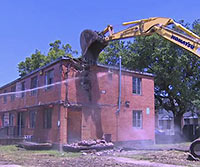 Yesterday, this Komatsu finished the job that Hurricane Ike started, taking out 63 damaged units of the Houston Housing Authority’s Kelly Village Apartments at 1119 Grove St. in the Fifth Ward — and at least one of the residents is happy to see ’em go: “Lacrecha St. Jules,” who wrote a letter to the Housing Authority requesting that something be done, reports the Houston Chronicle, “spent plenty of sleepless nights worrying about her four children as drug dealers and thugs made themselves at home in [the] vacant buildings. . . . ‘It was dark, and there were rapes back there . . . It was a bunch of negatives, and I just wanted to turn it into a positive.'” North of I-10 and east of U.S. 59, the apartments, which showed up in yesterday’s Daily Demolition Report, date to 1930; the city says it plans to build an $800,000, 3-acre park in their place, with room for a jogging trail and garden. [Houston Chronicle; previously on Swamplot] Photo: KHOU via Facebook
Yesterday, this Komatsu finished the job that Hurricane Ike started, taking out 63 damaged units of the Houston Housing Authority’s Kelly Village Apartments at 1119 Grove St. in the Fifth Ward — and at least one of the residents is happy to see ’em go: “Lacrecha St. Jules,” who wrote a letter to the Housing Authority requesting that something be done, reports the Houston Chronicle, “spent plenty of sleepless nights worrying about her four children as drug dealers and thugs made themselves at home in [the] vacant buildings. . . . ‘It was dark, and there were rapes back there . . . It was a bunch of negatives, and I just wanted to turn it into a positive.'” North of I-10 and east of U.S. 59, the apartments, which showed up in yesterday’s Daily Demolition Report, date to 1930; the city says it plans to build an $800,000, 3-acre park in their place, with room for a jogging trail and garden. [Houston Chronicle; previously on Swamplot] Photo: KHOU via Facebook
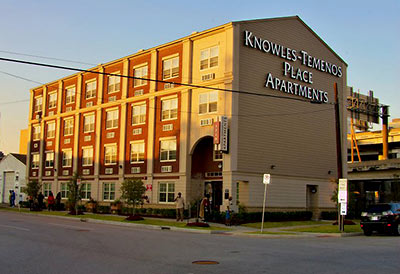
So these apartments might not have the same shimmery glamour as their namesake, Beyoncé Knowles. But the pop star and Houston native, moved by the devastation in New Orleans in the wake of Hurricane Katrina, did chip in with her sister, Solange, and mother, Tina — as well as Destiny’s Child co-star Kelly Rowland, St. John’s United, and Temenos CDC — to help provide housing for Houston’s low-income and homeless populations.
The 43-unit building (shown above) at 1719 Gray went up in 2007. Now, Temenos has laid out on its website plans for a second building — with almost twice as many units as the original — at 2200 Jefferson, less than a mile away on the east side of I-45.
There’s no mention whether Beyoncé is involved in Phase II. But there are renderings:

Charged with providing affordable public housing, the Houston Housing Authority is pulling out all the stops. All 171 remaining houses from its failed “scattered sites” public housing program intended for low-income families will now be offered . . . to the public. At auction. Included: the home shown above, sporting a Hurricane Ike-era blue roof tarp. Plus: 3 vacant lots! Where did all these amazing properties come from?
WHAT COUNTS FOR PUBLIC HOUSING IN HOUSTON The failure of the Houston Housing Authority’s “scattered sites” program has left the city agency as the proud owner of 174 vacant and decaying homes about town: “The houses, 365 in all, were purchased from the U.S. Department of Housing and Urban Development in 1987 and 1988. The agency upgraded the homes and opened them to public housing tenants as a way to provide rental houses to low-income families and eventually, a bridge for first-time homeownership. Since it began in the mid-1990s, the HHA program sold 191 houses, just over half. But in 2004, believing the houses would be more easily sold if renters weren’t living in them, they began moving tenants out. As of 2006, according to their records, 104 homes were still rented. Now, there are none. And yet, since 2007, just 27 houses have been sold – a mere dozen last year.” [Houston Chronicle]

Right on time for tonight’s public meeting, Swamplot’s “Bottom” of the Fifth Ward correspondent Vaughn Mueller sends in a bit of information about the proposed redevelopment of the Houston Housing Authority’s Kennedy Place apartments:
It is located in lower fifth ward, bounded by Bayou, Gillespie, Meadow and Baron streets. According to the HHA, it was built in 1982 but in its current condition, it looks reminiscent of a 1950-1960 1-story development. There is currently no central AC or heat in any of its 60 units.
In mid July a sign was put up out front describing the construction. Soon after, we received a notice of public meeting in the mail also describing the construction. The meeting is set for August 18th. The new development will contain 108 new apartments, 88 of which are going to be government assisted while 20 are going to be market rate.
The proposed site plan:

